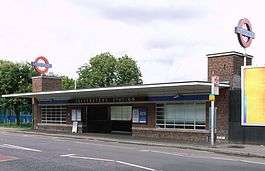Cockfosters tube station
| Cockfosters | |
|---|---|
 | |
 Cockfosters Location of Cockfosters in Greater London | |
| Location | Cockfosters |
| Local authority | London Borough of Enfield |
| Managed by | London Underground |
| Number of platforms | 4 (facing 3 tracks) |
| Fare zone | 5 |
| London Underground annual entry and exit | |
| 2012 |
|
| 2013 |
|
| 2014 |
|
| 2015 |
|
| Key dates | |
| 31 July 1933 | Opened (Piccadilly line) |
| Listed status | |
| Listing grade | II |
| Entry number | 1358718[2] |
| Added to list | 26 May 1987 |
| Other information | |
| Lists of stations | |
| WGS84 | 51°39′06″N 0°08′56″W / 51.6516°N 0.1488°WCoordinates: 51°39′06″N 0°08′56″W / 51.6516°N 0.1488°W |
|
| |
Cockfosters is a London Underground station on the Piccadilly line for which it is the northern terminus. The station is located on Cockfosters Road (A111) approximately nine miles (14 km) from central London and serves Cockfosters in the London Borough of Barnet although it is actually located a short distance across the borough boundary in the neighbouring London Borough of Enfield. The station is in Travelcard Zone 5 and the next station south-east is Oakwood.
History
The station opened on 31 July 1933, the last of the stations on the extension of the line from Finsbury Park to do so and four months after Oakwood station (then called Enfield West) opened. Prior to its opening, "Trent Park" and "Cock Fosters" (an early spelling of the area's name) were suggested as alternative station names. The original site hoarding displayed the name as a single word.
The station was designed by Charles Holden in a modern European style using brick, glass and reinforced concrete.[3] Compared with the other new stations Holden designed for the extension, Cockfosters' street buildings are modest in scale, lacking the mass of Oakwood or Arnos Grove or the avant-garde flourish of Southgate. Holden's early design sketches show the station with two towers.[4] The most striking feature of the station is the tall concrete and glass train shed roof and platform canopies which are supported by portal frames of narrow blade-like concrete columns and beams rising from the platforms and spanning across the tracks. The trainshed roof constructed at Uxbridge in 1937-38 was built to a similar design. Cockfosters station is a Grade II listed building.
The station has three tracks with platforms number 1 to 4; the centre track being served from both sides by platforms 2 and 3. This is an example of the so-called Spanish solution. Most eastbound Piccadilly trains terminate here although some terminate at Arnos Grove or Oakwood, particularly in peak hours or in the evenings. Some trains may even terminate at Wood Green, however, this is only used very early in the morning or in emergency situations. Cockfosters depot is located between Oakwood and Cockfosters and trains can access or leave it from either direction.
Nearby attractions
- Trent Park
- The "London LOOP" walk uses the station's foot tunnel to cross Cockfosters Road.
In popular culture
Cockfosters tube station features prominently in the novel While England Sleeps by American author David Leavitt. One of the novel's protagonists is writing a book entitled The Train to Cockfosters.[5]
Connections
London Buses routes 299, 384 and 298 and night route N91 serve the station.
Gallery
- Main entrance
- Western entrance
 Concourse
Concourse- Concourse
- Platforms 1 & 2 looking north (platforms 3 & 4 on the far right)
- Platforms 1 & 2 looking south (platforms 3 & 4 on the far left)
- Platforms 3 & 4 looking north with a Piccadily line train on platform 4
- Platforms 3 & 4 looking south (platforms 1 & 2 on the far right)
See also
References
- 1 2 3 4 "Multi-year station entry-and-exit figures" (XLS). London Underground station passenger usage data. Transport for London. April 2016. Retrieved 3 May 2016.
- ↑ "COCKFOSTERS LONDON REGIONAL TRANSPORT STATION INCLUDING PLATFORMS AND PLATFORM CANOPIES". National Heritage List for England. English Heritage. Archived from the original on 2013-08-15.
- ↑ Paulsen, Ingvild (14 June 2003). "Undergrunnsarkitektur". Dagens Næringsliv (in Norwegian). p. 28.
- ↑ "Underground Journeys: Cockfosters". Royal Institute of British Architects. Retrieved 20 February 2011.
- ↑ Max, D.T. (3 October 1993). "The Lost Language of Leavitt : WHILE ENGLAND SLEEPS By David Leavitt (Viking: $22; 304 pp.) ". Los Angeles Times.
External links
| Wikimedia Commons has media related to Cockfosters tube station. |
- London Transport Museum Photographic Archive
- Early sketch design by Charles Holden, 1931, Royal Institute of British Architects
| Preceding station | Following station | |||
|---|---|---|---|---|
| Piccadilly line | Terminus |